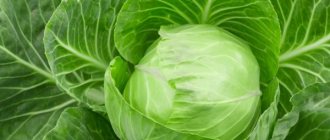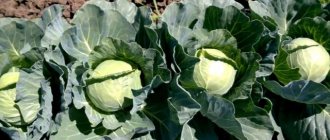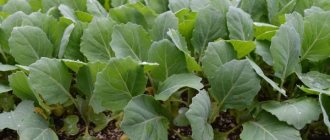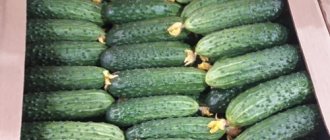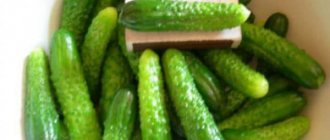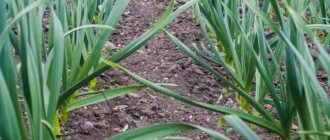Along with potatoes, white cabbage is a very popular food source vegetable. It is served as an independent dish, also added to salads, soups, and used as a side dish. But not a single Russian person can imagine how to do without sauerkraut salad in winter. In addition to the benefits of the substances that cabbage contains, the vegetable is rich in fiber, which allows even a person with a good appetite to quickly get enough. In addition, the price of cabbage still remains affordable for everyone. Nadezhda cabbage is a variety of white cabbage, chosen by many and actively grown in the country’s garden beds.
Description of cabbage variety Nadezhda
The Nadezhda cabbage variety is valued primarily for the density of heads of cabbage and high, stable yield, little dependent on weather conditions. She is rarely affected by disease.
The leaf rosette of young cabbage Nadezhda looks semi-spreading in the photo. The upper leaves are large, with a wavy edge. The color of the leaves is from green to dark green, with a pronounced waxy coating. The head of cabbage itself is formed by light green leaves. The waxy coating is absent or insignificant, almost invisible to the eye. The cut is white, with a short stalk and no voids.
Nadezhda cabbage produces flat-rounded, even-sized heads of cabbage with an average weight of 3-3.5 kg. The heads of cabbage are very dense, the leaves adhere well to each other.
According to descriptions of the variety and reviews from gardeners, the taste of Nadezhda cabbage is rated as excellent. The leaves, despite their increased density, are quite thin and remain juicy and tender for a long time. They have a sweetish taste.
White cabbage Nadezhda is an unpretentious variety. The main problem for vegetable growers in the middle zone is the need to grow it through seedlings. In addition, the Nadezhda variety, like most types of cabbage, is demanding on site lighting and soil fertility. The fact that plants are rarely affected by pests makes care much easier.
Cabbage variety Nadezhda, a description and photo of which is given in the article, is zoned for all regions of the Russian Federation, with the exception of the Far North. Excellent characteristics allow it to be grown in the unstable climate of the middle zone, short daylight hours in the northern and northwestern regions and in the arid southern regions.
Place and land for planting
The soil for planting should be nutritious and loose
You can grow the Nadezhda cabbage variety only in a well-lit, open area. If there is not enough sun, the growing season will be prolonged. In addition, when growing in the shade, cabbage accumulates more harmful substances, the cabbage becomes loose and not dense, and its keeping quality decreases. Nightshades and melons are considered good predecessors.
Important!
When grown in acidic soil, cabbage often suffers from clubroot.
The soil for planting should be nutritious and loose. In the fall, it is fertilized with humus, and in the spring, potassium, calcium and nitrogen are added. You can apply mineral fertilizers during spring digging or simply put a little into the holes during planting. In addition, before planting, you need to check the acidity of the soil. It should be neutral.
Diseases and pests
Nadezhda cabbage has high immunity to most diseases, including gray rot. To achieve good results for disease prevention, crop rotation is observed. Cabbage should not be planted after other cruciferous vegetables, which include radishes, daikon, and turnips. These vegetables should not be planted next door either.
The Nadezhda variety is rarely affected by pests. However, in hot and dry years, planting may be attacked by the cruciferous flea beetle. Vegetable growers have many traditional ways to combat this pest, including mulching the soil with ash or treating the plantings with an infusion of hot pepper.
Planting care
To obtain consistently high yields, Nadezhda cabbage must be properly cared for.
For pests and diseases you can use “Fitoverm”, “Iskra D”
- Water for irrigation is always taken warm, standing in the sun. Water at the root so as not to get on the leaves. This procedure must be done so that the ground is slightly damp all the time.
- After watering, loosening is carried out when the water is absorbed. The soil should always be a little fluffy, not hard!
- During the development period, cabbage is fed approximately 3-4 times. The first feeding is done 3 weeks after planting in a permanent place. The second - 12 days after the first, and the third after another 2 weeks. When the green mass of cabbage is growing, it is necessary to feed it with nitrogen, and later, when the head of cabbage is forming, potassium and phosphorus are taken.
Important!
If the cabbage gets too much water, its leaves will begin to fall off.
- Hilling is carried out several times during the season so that the plant builds up its root mass and becomes stronger. If you don’t hill up the cabbage, you won’t have to wait for large, developed heads of cabbage. This procedure is needed until the cabbage tops begin to cover the row spacing.
- The Nadezhda variety often suffers from bacteriosis, so spraying against this disease will not hurt. They can be done preventively so that it does not come to treatment. Specialized products are usually used for spraying. You can also scatter dry wood ash around the plants.
- For pests and diseases, you can use such drugs as “Fitoverm”, “Iskra D”. Caterpillars are collected by hand or using folk recipes.
Reviews about Nadezhda cabbage
Polina, 35 years old, Velikiye Luki I have been growing the Nadezhda variety in my summer cottage for several years. And its stable productivity is always amazing. Rain or drought, cold or hot, he will always please you with the harvest. Of course, today there are varieties of cabbage whose heads grow up to 6-7 kg. Just whether they are necessary.
Daria, 45 years old, Kostroma I have been planting Nadezhda for several years now, and only recently found out that it is a rather old variety. I didn’t believe it for a long time. Its resistance to cold and drought, immunity to disease is quite at the level of more modern species. And the taste is simply wonderful. This cabbage is stored in the cellar until almost spring. I like.
Harvest and storage
The harvest is harvested in August – September. More precise dates are determined by the condition of the heads of cabbage: they will become dense, voids will not be felt, and the lower leaves will droop.
The cabbage is dug up with roots, the heads are cut off, leaving 3-4 covering leaves and a stalk 3-4 cm long. The harvest is inspected and put aside for early consumption, or specimens that have mechanical damage or signs of disease are thrown away.
Heads of cabbage suitable for storage are taken to a cellar or basement, where under proper conditions (air temperature - -1...+1°C, humidity level - 90–98%) they are stored for 5-6 months.
Seedless growing method
Being a frost-resistant crop, cabbage can grow when sown directly into the ground. The advantage of such cultivation is the absence of transplants, which cabbage does not tolerate well. As a rule, early and middle varieties are grown in this way.
Features of the seedless method:
- Cabbage is sown in late April-early May.
- The soil is carefully dug up and fertilized. Prepare the holes in the same way as when planting seedlings. For example, 30x40 cm. Between adjacent plants - 30 cm, between rows - 40 cm. The distance is selected depending on the variety and ripening time.
- Fertilizers are added to each hole - half a bucket of compost or humus, as well as 0.5 liters of ash. 5-6 seeds are placed in one hole. If there are doubts about germination, add a dozen seeds. The seeds are covered on top with a soil mixture of fertile soil, peat and humus.
- The plantings are watered, and so that the seeds sprout as quickly as possible, they are covered with a double layer of non-woven material or film. The covering material is removed no later than the second true leaf appears. If the film is not removed in time, the cabbage will stretch out and its stems will bend.
- It will take about a month until the seedlings grow and get stronger, acquiring 3-4 true leaves. All this time, careful care is required - weeding, treatment with preventive agents.
- When the seedlings have 4-6 true leaves, they are thinned out, leaving the strongest sprouts, only one plant in one hole.
Advantages and disadvantages of the variety
The high popularity is explained by the wide list of advantages of the culture and the almost complete absence of disadvantages. The advantages of the Nadezhda variety include:
- good taste of the product;
- a large number of useful substances in the composition;
- long shelf life of heads;
- suitability of cabbage for transportation over long distances;
- versatility in terms of methods of use;
- resistance to frost (up to -5 degrees) and heat (up to 25 degrees);
- resistance to cracking and bolting.
As for the disadvantages of Nadezhda, they include low resistance to disease. The plant is especially susceptible to clubroot and bacteriosis.
Seedlings are the key to harvest
As a rule, the Nadezhda variety is grown through seedlings. To do this, prepare containers or a greenhouse outside.
Soil preparation
- The soil should be fertile, but not acidic. Most often, gardeners themselves prepare the soil composition from turf soil, sand, and peat. All components are taken equally.
- It is useful to add a small amount of wood ash to the soil, as in the photo below. It contains all the microelements necessary for the plant. In addition, ash deoxidizes the soil and prevents the development of blackleg.
- Then the soil is spilled with boiling water with dissolved potassium permanganate. This procedure helps get rid of disease spores and pest larvae.
Preparing and sowing seeds
Before sowing, seeds must be disinfected for about 20 minutes in hot water (not higher than 50 degrees), if they are not coated. Then dip into cold water. If desired, and if growth activators are available, you can use them.
Sow the seeds in moist soil to a depth of 0.5 cm, water carefully so as not to wash away the surface. Then cover with glass or film, which is removed after the first sprout appears.
In a greenhouse or nursery, the temperature should not be high, otherwise the seedlings will stretch. But the lighting is maximized.
Seedlings can be picked, but this is not necessary. The main thing is that the seedlings do not grow densely: weak shoots must be removed. When they reach 20 cm in height and 5-6 true leaves appear, the seedlings are planted in a permanent place.
When caring for seedlings, monitor soil moisture. It should not be allowed to dry out, but it should not be flooded either. Too wet soil can cause root rot.
Varieties of white cabbage:
History of the variety
Nadezhda cabbage was bred by Siberian breeders in 1969. Special efforts were made by NIIOH scientist N.M. Nasrullaev. The variety is a hybrid obtained from two different varieties of the Cabbage family: Dense Cabbage and Slava Enkgeusen.
Six years later, after undergoing careful selection and entering this variety into the State Register of the Russian Federation, the species received its recognition and place on farms. A few years later, this species gained wide popularity not only at agricultural enterprises, but also among private gardeners.
Head of cabbage close-up
Features of agricultural technology
This type of cabbage is suitable for sowing in open soil and for growing seedlings. The second option is more preferable for gardeners, since by the time of planting the seedlings will already have become noticeably stronger and will easily take root in open soil. In general, the procedure for growing a crop is standard and does not involve any special difficulties.
Growing seedlings
Already in the fall, it is recommended to prepare the soil for planting plants and the appropriate containers (boxes or individual cups). An earthen substrate for planting is prepared by mixing peat with sand, a small amount of ash and soil from the garden. All components, except ash, are taken in equal proportions. After mixing, the substrate is poured with copious amounts of boiling water with potassium permanganate to disinfect.
Water with potassium permanganate
The Nadezhda cabbage harvest is usually scheduled for late August - early September. Accordingly, sowing seeds for seedlings is carried out from the end of March to the first ten days of April. The procedure is carried out using the following technology:
- In the box, every 2-3 cm, furrows are made for planting, 0.5-1 cm deep. Plenty of warm, settled water is poured into the grooves.
- The day before planting, the seeds are disinfected in hot water. 2-3 hours before sowing, they can also be soaked in a solution of Zircon, Albit or similar biostimulants.
- After preparation, the seeds are placed in grooves in increments of 2 cm.
- The rows are covered with soil on top and sprinkled with water.
After planting the seeds, the box is covered with glass and put away in a well-ventilated, bright place.
The first shoots appear after 3-4 days. During this period, the room temperature is set at 20–24 degrees. After sprouts are detected, it is reduced to 14–16 degrees. Caring for young plants involves the following nuances:
- In addition to natural lighting, lamps are also installed above the box for additional illumination.
- Watering is carried out as the top layer of soil dries. At the same time, excessive moisture should be avoided. After watering, the soil is loosened.
- After two weeks, when 2-3 leaves grow on the seedlings, they are picked into separate containers.
- The plantings must be fed.
Fertilizer is applied to the soil twice. The first time when two true leaves appear on the plants. The second feeding is carried out 4 days before planting the seedlings in the ground. In both cases, the following composition is used as fertilizer:
- 10 liters of water;
- 25–30 g of potassium chloride;
- 30 g phosphates;
- 15 g urea.
All components are mixed and the liquid is carefully poured under each bush.
Important! 8–10 days before the intended transfer to the garden bed, the seedlings are hardened off. In the first days, simply open the window for ventilation. Then the boxes are taken outside for 3–4 hours. In recent days, she has been completely left in the fresh air around the clock.
Terms and rules for transplanting into the ground
Seedlings of this species are ready for planting in open soil within 25–30 days after the first shoots appear. Moreover, each transplanted seedling should have 4–5 true leaves, and the plant’s height should be at least 20 cm.
The area for planting is prepared in late autumn. The site chosen is one that has not had cabbage, radishes, horseradish, or turnips in the last couple of years. After such crops, pathogenic microorganisms may remain in the soil.
Humus for fertilizer
Be sure to add humus or manure to the site in the fall. Inorganic potassium, nitrogen and phosphorus mixtures are used carefully, since their excess can harm vegetation. The recommended scheme is 10 kg of manure and 30 g of superphosphate for each square of bed area.
In the spring, the area is carefully leveled and, if necessary, weeds are removed. The transplant itself is carried out as follows:
- On the prepared site, holes 25 cm deep are dug at a distance of 60 cm from each other. As an alternative, furrows can be made with the same depth and a row spacing of 50–60 cm.
- The soil in the depressions is watered until a viscous consistency is obtained.
- Seedlings in cups are also watered. After this, it is removed along with the soil and placed in a hole (furrow).
- The top of the hole is sprinkled with earth so that there is still a 2-3 cm depression left to the surface.
Reference. At first, until the seedlings take root, it is recommended to cover them with cardboard or buckets to minimize burning of the leaves by direct sunlight.
Caring for Nadezhda cabbage
Proper care of cabbage consists of timely watering of the beds and applying fertilizers. Water the seedlings every day for the first week, pouring 1 liter of water under the bush. After the roots of the plants become stronger and they begin to grow, the frequency of watering is reduced to one or two times a week (depending on weather conditions). At this time, about 4 liters of water are already spent on each bush. In case of increased dryness, moisten the vegetation in the morning by sprinkling. If there is no heat, it is enough to use drip irrigation.
After each watering, it is recommended to loosen the top layer of soil so that a crust does not form on it, preventing the passage of air and moisture to the roots. Also, in parallel with watering, weeds are removed from the beds and hilling is carried out (once every 10–15 days). In this case, first, dry soil is raked from the surface, and wet soil is raked to the stump. Then the dry soil is returned back.
Another mandatory point in caring for growing cabbage is fertilizing the soil. Fertilizing is applied three times during the cabbage growing season:
- The soil is fertilized for the first time 2 weeks after planting the seedlings. To do this, take 20 g of superphosphate, 20 g of potassium chloride and 10 g of urea for each square of area.
- The second feeding is planned for the initial period of head set. At this time, the components of the composition are not changed, only the amount of superphosphate is increased to 30 g.
- The third feeding is carried out 2 weeks after the previous one, and urea is completely removed from the mixture.
Reference. For greater variety, one or two feedings can be carried out using solutions of mullein (1:10) or bird droppings (1:15).
Diseases and pests of crops
Nadezhda cabbage is susceptible to bacteriosis and clubroot. As a preventive measure, in both cases, thoroughly water the holes when transferring seedlings to the beds with boiling water with dissolved potassium permanganate. Special chemicals also help in the fight against bacteriosis. When clubroot disease occurs, infected plants must be promptly removed from the garden bed.
White butterfly caterpillar
The main pests of cabbage are white moth and cutworm caterpillars. You can get rid of these and other insects by spraying wood ash on the bushes and around them. Also, dill or marigolds are often planted between plants, which repel pests with their smell. Of the chemicals used to combat insects, Fitoverm, Karate, Iskra and other insecticides help.
Timing of harvesting and storage of heads of cabbage
As already noted, full ripening of heads of cabbage occurs 80–90 days after planting the seedlings. By this time, the forks acquire a characteristic density, and the lower leaves gradually dry out. When planning harvesting, the main thing to remember is that you should not allow ripened cabbage to remain in the beds if the temperature drops to -6. This significantly reduces shelf life.
The method of storing assembled heads directly depends on the specific direction of their use. Heads of cabbage intended for fermentation should be quietly left in a dry, ventilated area. If you plan to save the crop for the winter, then it is better to immediately put it in a cool basement. Moreover, before hiding the supplies, they must be carefully sorted and dried outside.
Nadezhda cabbage has been grown in Russian gardens for almost four decades. And the constantly growing assortment of new varieties has not diminished interest in this proven variety. The reasons for this demand are high yield, long shelf life, and good taste of the vegetable. Moreover, the technology for growing such a crop does not involve any particular difficulties, and even novice summer residents can master it.

